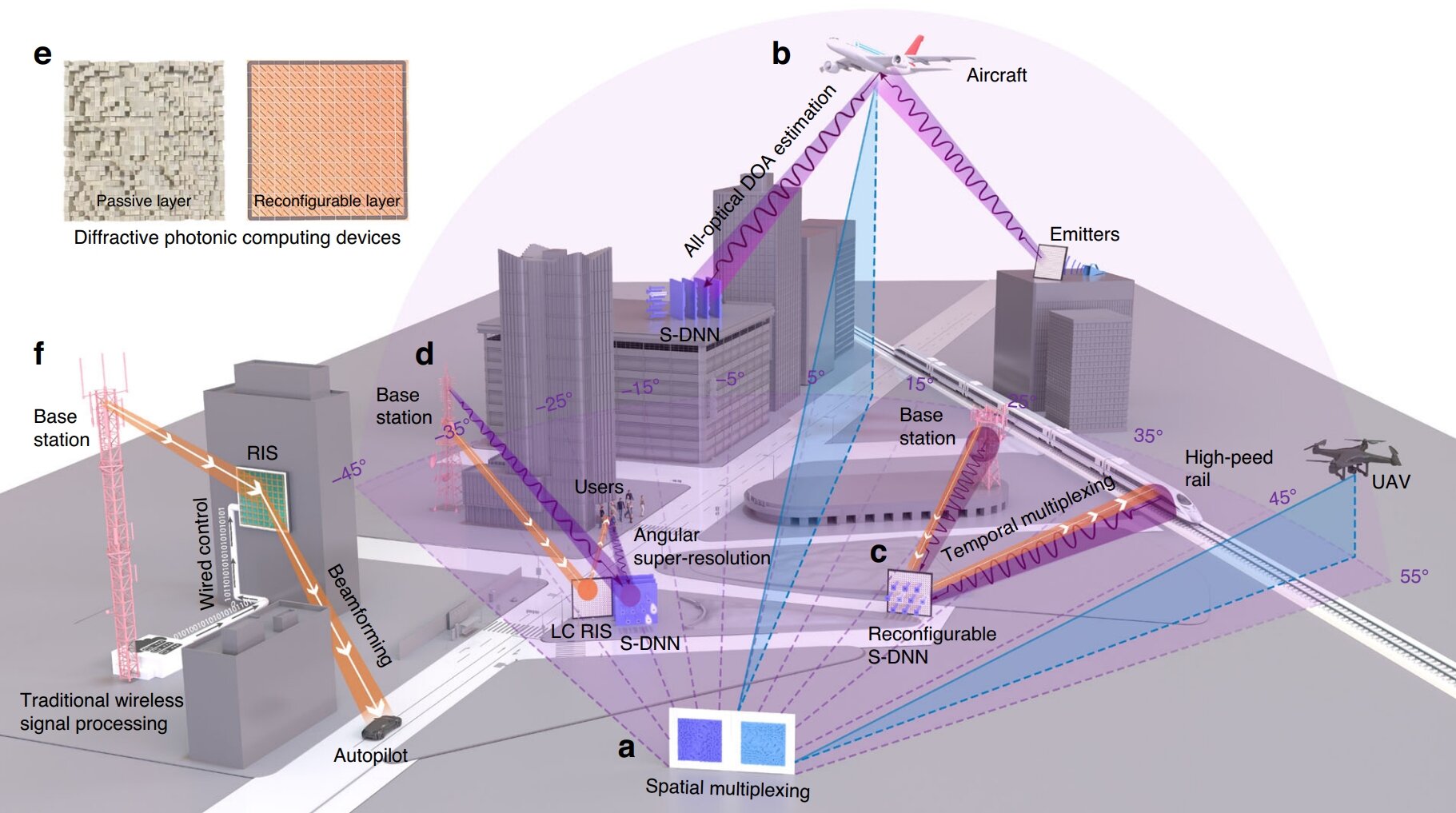Wireless sensing and communication have become integral components of modern life. Among them, the key technology of direction-of-arrival (DOA) estimation, which utilizes array signal processing techniques to measure the angular direction of RF signals, has been widely applied in both civilian and military domains.
Traditional DOA estimation methods, such as the multiple signal classification (MUSIC) algorithm, require a significant amount of RF circuitry to receive multi-channel signals, perform down-conversion and high-speed sampling, and then conduct digital signal processing.
The high complexity of hardware and algorithms, as well as the extensive data, significantly increase the latency, power consumption, and cost of traditional signal processing systems. Hence, there is an urgent need to develop novel computational paradigms that can replace electronic processors and more efficiently process RF signals, enabling low-latency, high-performance, and cost-effective DOA estimation.
As a novel computing paradigm, optical computing possesses immense advantages in terms of computational speed, throughput, and energy efficiency, offering a breakthrough in overcoming the energy efficiency bottleneck of the von Neumann architecture.
To directly process RF signals, diffractive neural networks have been constructed for large-scale spatial optical computing. These networks modulate electromagnetic waves at the speed of light and process the information they carry, enabling tasks such as object recognition and wireless encoding/decoding.
However, the angular resolution of existing diffractive neural networks remains constrained by the diffraction limit, and their application in advanced wireless sensing tasks has yet to be explored.
Furthermore, there is a lack of angle sensing and computing capabilities in utilizing reconfigurable intelligent surfaces (RIS) to modulate spatial electromagnetic waves and build next-generation communication systems.
In a paper published in Light: Science & Applications, a team of scientists, led by Professor Xing Lin from Department of Electronic Engineering, Tsinghua University, China, and co-workers have developed a super-resolution diffractive neural network (S-DNN) for all-optical DOA estimation across a wide frequency range, achieving an angular resolution that surpasses the Rayleigh diffraction limit.
By directly processing spatial electromagnetic (EM) waves, S-DNN enables DOA estimation at the speed of light without the need for traditional RF circuits, ADCs, or digital signal processing.
Moreover, S-DNN achieves higher angular resolution and more robust estimation results against input noise compared to the MUSIC algorithm, requiring only a single snapshot. Researchers have also applied the DOA estimation capability of S-DNN to provide user angle information for RIS, enabling low-latency and low-power Integrated Sensing and Communication.
The scientists summarize the working principle of S-DNN: Since the phase distributions of EM waves emitted by target sources at different angles vary in the far-field plane, S-DNN determines the angle of the target by identifying the phase distribution of the EM field. To achieve precise modulation of EM waves, S-DNN consists of multiple cascaded diffractive modulation layers.
By setting 10 detection regions in the output plane, each corresponding to an incident angular interval, when EM waves are input, the angular interval of the target source is determined by comparing the EM field intensities of the 10 detection regions and finding the maximum value.
Angular resolution is a crucial metric for RF direction-finding systems, representing their ability to distinguish between signals from two closely adjacent angles. However, due to the limitation of array aperture, the angular resolution of existing systems has been difficult to surpass the Rayleigh diffraction limit.
Researchers have optimized and fabricated a four-layer passive S-DNN based on deep learning, achieving a super-resolution DOA estimation with an angular resolution of 1°, which is four times higher than the diffraction-limited resolution.
The high degree of freedom design space with multiple metasurfaces and large-scale diffractive modulation meta-atoms enables S-DNN to generate super-oscillatory angular responses within local angular intervals, thus achieving DOA estimation beyond the diffraction limit.
From the perspective of spectrum shifting, S-DNN’s precise modulation capability can shift sparse spectral components beyond the diffraction-limited into the diffraction-limited frequency range. Through testing, S-DNN achieved a 99% accuracy rate in both single-target and two-target DOA estimation tasks.
Due to the increasing complexity of real-world EM environments, coherent signal sources on RF direction-finding systems, along with continuously broadening signal frequency ranges, pose challenges. Traditional narrowband MUSIC algorithms are unable to achieve broadband DOA estimation for coherent target sources.
To address these issues, researchers have proposed a broadband training method based on deep learning, significantly enhancing the anti-dispersion capability of S-DNN and enabling it to achieve broadband super-resolution DOA estimation for multiple coherent target sources. Utilizing this training method, a three-layer S-DNN has been optimized and fabricated, achieving a super-resolution DOA estimation with an angular resolution of 3° within the frequency range of 25 GHz to 30 GHz.
To further validate the performance of S-DNN, researchers conducted full-wave simulations of the trained model using the EM field simulation software CST, followed by experimental measurements on the fabricated S-DNN.
As a pivotal technology in the 6G era, RIS lacks sensing and computing capabilities, rendering its large-scale deployment challenging due to its reliance on base station control. However, S-DNN offers the potential to replace base stations in achieving light-speed DOA estimation for multiple mobile users, providing crucial prior information for subsequent wireless communication processes.
This study proposes leveraging S-DNN’s broadband angle sensing capabilities to enable RIS to autonomously perceive the electromagnetic environment independently from the base station, facilitating real-time communication links between base stations and high-speed mobile users.
Researchers have developed a reflective liquid crystal RIS system with a phase modulation accuracy of up to 5 bits per meta-atom, enabling beamforming and the realization of a reconfigurable S-DNN. Initially, the passive S-DNN receives electromagnetic waves from base stations and mobile users, estimating the angles of multiple targets with minimal delay.
Based on the S-DNN’s estimation results, an FPGA generates control voltages and configures the RIS to reflect electromagnetic waves from the base station to users, achieving beamforming tracking. The experiment achieved an average detection amplitude gain of 17.9 dB at the user end, demonstrating the effectiveness of the proposed integrated communication and sensing system.
In summary, this research work demonstrates the significant potential of all-optical computing in overcoming the physical limitations of sensing systems.
Leveraging the optical computing architecture of S-DNN, the all-optical DOA sensing latency is reduced by over 2–4 orders of magnitude compared to the most advanced radio frequency direction-finding devices, making it an ideal choice for autonomous driving and high-speed rail communication.
Moreover, S-DNN equipped with high-power transmitters holds promise for applications in radar target detection and tracking, as well as satellite navigation and positioning.
More information:
Sheng Gao et al, Super-resolution diffractive neural network for all-optical direction of arrival estimation beyond diffraction limits, Light: Science & Applications (2024). DOI: 10.1038/s41377-024-01511-4
Citation:
Optical computing empowers direction of arrival estimation beyond the diffraction limit (2024, September 3)
retrieved 3 September 2024
from
This document is subject to copyright. Apart from any fair dealing for the purpose of private study or research, no
part may be reproduced without the written permission. The content is provided for information purposes only.






